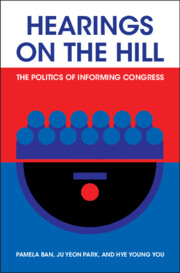Book contents
- Frontmatter
- Dedication
- Contents
- Figures
- Tables
- Acknowledgments
- 1 Members of Congress Are Politicians, Not Experts
- 2 Committee Hearings and Information Provision in Congress
- 3 Who Testifies in Congress? New Data on Congressional Hearings and Witnesses
- 4 Not All Information Is Equal
- 5 When Committees Seek Out Information for Policy Development
- 6 How Control of Government Shapes Information Exchange
- 7 Congressional Capacity and the Search for Specialized Information
- 8 Conclusion
- Appendix A
- References
- Index
6 - How Control of Government Shapes Information Exchange
Published online by Cambridge University Press: 21 November 2024
- Frontmatter
- Dedication
- Contents
- Figures
- Tables
- Acknowledgments
- 1 Members of Congress Are Politicians, Not Experts
- 2 Committee Hearings and Information Provision in Congress
- 3 Who Testifies in Congress? New Data on Congressional Hearings and Witnesses
- 4 Not All Information Is Equal
- 5 When Committees Seek Out Information for Policy Development
- 6 How Control of Government Shapes Information Exchange
- 7 Congressional Capacity and the Search for Specialized Information
- 8 Conclusion
- Appendix A
- References
- Index
Summary
In this chapter, we examine how the politics of interbranch relations between the legislature and the bureaucracy affect the invitation of bureaucratic witnesses to hearings and how Congress can use hearings to control executive branch influence. We focus on the presence of divided government – when the party controlling Congress is not the party that controls the White House. We find that during periods of divided government, committees invited relatively fewer bureaucrats to testify; instead, they invited relatively more witnesses from think tanks, universities, and within Congress itself. This result is particularly pronounced when hearings were held on issues that the president prioritized. These findings are substantively important, especially given how the existing literature has characterized bureaucrats’ advantages in information and expertise in policy implementation vis-à-vis Congress. We provide evidence that under divided government, committees limited the amount of expert information from the executive branch that could be favorable to a president from the opposing party and instead welcomed outsiders to compensate for the relative loss of information from bureaucrats.
Keywords
- Type
- Chapter
- Information
- Hearings on the HillThe Politics of Informing Congress, pp. 98 - 121Publisher: Cambridge University PressPrint publication year: 2024

